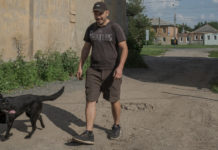One week ago, Al-Sharina and his children returned to their former home in the town of Hajin, on the Euphrates River in eastern Syria. A coalition of US-backed Syrian Democratic Forces (SDF), Kurdish soldiers and Arab tribesmen liberated Hajin from the so-called Islamic State in December.
In the process, nearly every building in Hajin’s centre was damaged or destroyed. “Life was hard under ISIS,” said Al-Sharina, a man in his forties. “But it’s still hard, harder still with this destruction.” The back wall of his house has been completely demolished, and the front pocked with bullets. Every window in the house has been blown out.
Before ISIS came, Al-Sharina made a living trading livestock in this verdant and remote corner of Syria. He and his family fled soon after ISIS charged into town in 2014. What followed were years of moving from one camp for the displaced to another, from one relative’s house to another.
His children haven’t been to school in seven years, he told me. Now they are helping him clear away the rubble and repair damage to make the family home habitable again.
It won’t be easy. “There’s no food here, there’s no water. Nothing,” he shrugs.
His seven-year old son, Mohammed, is too young to help, and amuses himself by pushing a spare car tire around the yard. Syria’s nightmare is a year older than him. He has known nothing else.
Wastelands after the war against ISIS
As the war against ISIS wanes, civilians returning to their homes in Iraq and Syria are discovering wastelands where towns once stood — urban moonscapes of twisted metal, shattered concrete, unexploded bombs and mines.
Hajin’s main roundabout has become a deep pit where a coalition bomb exploded. Just up the road, the town’s only hospital is empty, a bullet- and shell-pocked skeleton. There is no electricity, no running water, no schools and no public services.
Yet people are returning. Trucks piled high with household goods from mattresses to treadmills are driving into town, after showing identification at a checkpoint manned by coalition soldiers. ISIS may have been driven out a month ago, but the threat of sleeper cells is very real.
Zahra returned to Hajin two days ago, after moving from camp to camp. She has already set up a table by the road where she sells candy, Kleenex and cigarettes.
Seated on a chunk of concrete, she looks around at the ruins that were Hajin. “Only stones are left,” she says.
A rubble-strewn last stretch to victory
Impatience seems to mark the last battles in the coalition’s fight against ISIS. If victory means destroying the towns and villages that ISIS once controlled, so be it, suggests the bomb-cratered road between Hajin and the frontlines.
The final line between territory controlled by the SDF and ISIS is an earthen berm on the outskirts of Baghouz Al-Fawqani, the only town still under ISIS control in the area. Occasional cracks of gunfire echo across the no-man’s land, while barely visible coalition warplanes roar overhead. While we were there, a mortar round crashed into the ground just a few hundred steps away.
Through binoculars, it’s easy to see men on motorcycles driving on the perimeter of the occupied town, as well as the occasional truck. What looks like a field full of tents, with wood fires burning, is also plainly visible. SDF officers estimate around 2,000 people are still inside Baghouz Al-Fawqani, a number that includes around 500 ISIS fighters. The remainder is thought to be the families of ISIS members and a handful of the town’s original inhabitants.
The SDF faces a particular challenge now: As ISIS has shrunk from its once-vast realm stretching from the outskirts of Baghdad to western Syria, some of the group’s most dedicated and fanatical followers have ended up concentrated here.
“Here we are facing their most ruthless fighters,” says Adnan Afrin, commander of SDF forces at the front. “There are Iraqis, Europeans and others from around the world, and they still have the will to fight.”
He denies rumors that negotiations are underway to evacuate ISIS fighters and their families to Idlib Province in western Syria, the last part of the country occupied by anti-regime forces. “Our goal is to completely destroy the ISIS terrorist organization,” he says.
In a speech at the State Department on Wednesday, Donald Trump predicted that the coalition would soon liberate “100% of the caliphate” established by ISIS in Syria and Iraq, as early as next week. The US President added that he wants “to wait for the official word” to announce victory.
But Commander Adnan is under no illusion that victory in the current battle will mean a total victory over the extremist group. “ISIS isn’t finished yet,” he told me. “It’s still in this area. It’s still fighting. It still has sleeper cells in the areas we’ve liberated.”
If the SDF can retake Baghouz Al-Fawqani, the end of an important battle against ISIS will be in sight. But the war is far from over.
Source : Nbcnewyork













